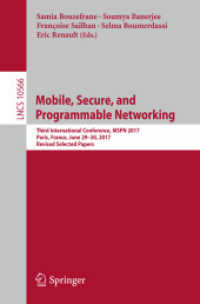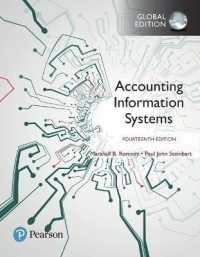- ホーム
- > 洋書
- > 英文書
- > Nature / Ecology
Full Description
Why Elephants Cry is a fascinating frolic through the literature and evidence surrounding the use of unusual behavior of animals to measure and predict the environment. The role of animals, from the smallest ant to the biggest elephant, as predictors of environmental changes is framed around the climate crisis, which highlights the increasingly important part that animals will have to play in the future.
Renowned biologist Professor John T. Hancock collects anecdotal stories and myths along with scientific evidence, demonstrating that observation of animals can be of tangible use. He looks at the measurement of the air temperature using ants, crickets and snakes, and goes on to assess the evidence that the observation of a wide range of animals can predict the weather or the imminent eruption of volcanoes and earthquakes. Evidence of animals being able to predict lunar and solar events, such as lunar cycles and the Northern Lights, is also considered.
This is the only time that all this literature has been brought together in one place, a fascinating reference for anybody interested in animals and the environment. The book is also an ideal supplementary textbook for students studying animal behaviour.
Contents
Introduction. Introductory Story. Predicting our Environment. Technological and Biochemical Approaches to Measuring the Environment. Why Animals May Alter Their Activities with Environmental Change. Long Term, or the Here and Now. Piquing my Interest. Relevance and Climate Change. Chapter Summary. Measuring Ambient Temperature. Introductory Story. Measuring the Air Temperature with an Animal - an Introduction. Importance of measuring temperature. Instrumentation which has been developed to measure temperature. Measuring temperature with an animal. Biochemical Explanation- why animals move faster as the temperature rises. Chapter Summary. Predicting the Weather. Introductory Story. The Weather and Animals - an Introduction. Why Watch the Weather. Instrumentation which has been Developed to Measure the Weather. Animals and how they can be Used to Predict the Weather. Biochemical Explanation - What Animals may be Sensing to Predict the Weather. Chapter Summary. Predicting Earthquakes, Volcanic Eruptions and Tsunami. Introductory Story. Earthquakes and Other Rumblings - an Introduction. Instrumentation which has been developed to Detect Movements of the Ground. Why Predicting Geophysical Events is Important. Animals and how they can be Used to Predict the Geophysical Events. Biochemical Discussion - What Animals may be Sensing to Predict Movements of the Earth. China and seismic zoos. Animals in the Prediction of Tsunamis and Volcanic Eruptions. Climate Change and Impact on Geophysical Events. Chapter Summary. Solar and Lunar Activity. Introductory Story. Solar and Lunar Events - an Introduction. Instrumentation which has been Developed to Observe the Skies. Animals and the Events in the Sky. Biochemical Discussion - What Animals may be Sensing during Lunar Events. The Solar Eclipse, Northern Lights, and Animals. Chapter Summary. Conclusions, Climate Change and the Future. Introductory Story. The Environment - an Introduction. Differences of Weather Impacts Around the World. Are Animals of Use as Environmental Predictors? Observation of Plants as Environmental Predictors. Use of Sentinel Organisms for Environmental Monitoring. Some of the Famous who have Dabbled. Climate Change. A Final Look at the Biology Behind Animal Sensing. Conclusions and Future.





